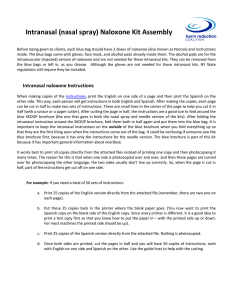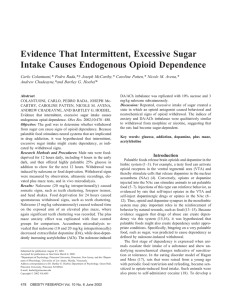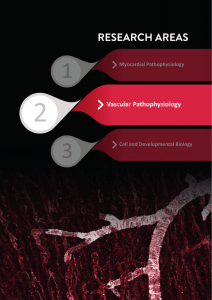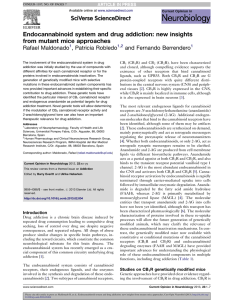Effects of phosphodieastrase type 5 inhibitions on
Anuncio
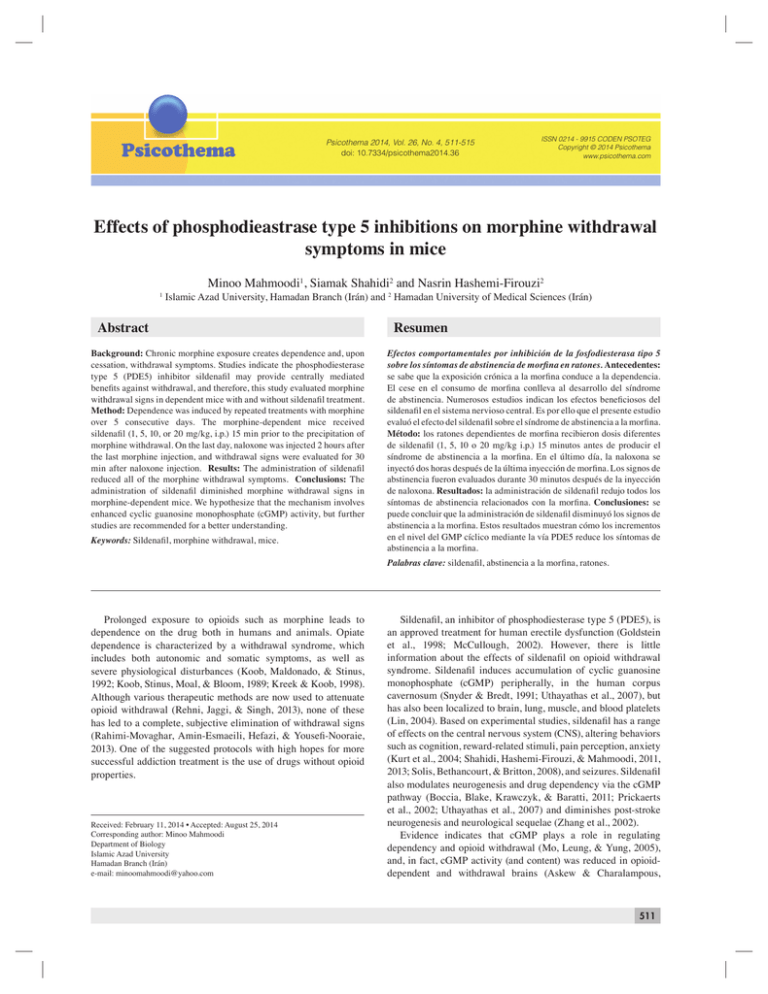
Psicothema 2014, Vol. 26, No. 4, 511-515 doi: 10.7334/psicothema2014.36 ISSN 0214 - 9915 CODEN PSOTEG Copyright © 2014 Psicothema www.psicothema.com Effects of phosphodieastrase type 5 inhibitions on morphine withdrawal symptoms in mice Minoo Mahmoodi1, Siamak Shahidi2 and Nasrin Hashemi-Firouzi2 1 Islamic Azad University, Hamadan Branch (Irán) and 2 Hamadan University of Medical Sciences (Irán) Abstract Background: Chronic morphine exposure creates dependence and, upon cessation, withdrawal symptoms. Studies indicate the phosphodiesterase type 5 (PDE5) inhibitor sildenafil may provide centrally mediated benefits against withdrawal, and therefore, this study evaluated morphine withdrawal signs in dependent mice with and without sildenafil treatment. Method: Dependence was induced by repeated treatments with morphine over 5 consecutive days. The morphine-dependent mice received sildenafil (1, 5, 10, or 20 mg/kg, i.p.) 15 min prior to the precipitation of morphine withdrawal. On the last day, naloxone was injected 2 hours after the last morphine injection, and withdrawal signs were evaluated for 30 min after naloxone injection. Results: The administration of sildenafil reduced all of the morphine withdrawal symptoms. Conclusions: The administration of sildenafil diminished morphine withdrawal signs in morphine-dependent mice. We hypothesize that the mechanism involves enhanced cyclic guanosine monophosphate (cGMP) activity, but further studies are recommended for a better understanding. Keywords: Sildenafil, morphine withdrawal, mice. Resumen Efectos comportamentales por inhibición de la fosfodiesterasa tipo 5 sobre los síntomas de abstinencia de morfi na en ratones. Antecedentes: se sabe que la exposición crónica a la morfina conduce a la dependencia. El cese en el consumo de morfina conlleva al desarrollo del síndrome de abstinencia. Numerosos estudios indican los efectos beneficiosos del sildenafil en el sistema nervioso central. Es por ello que el presente estudio evaluó el efecto del sildenafil sobre el síndrome de abstinencia a la morfina. Método: los ratones dependientes de morfina recibieron dosis diferentes de sildenafil (1, 5, 10 o 20 mg/kg i.p.) 15 minutos antes de producir el síndrome de abstinencia a la morfina. En el último día, la naloxona se inyectó dos horas después de la última inyección de morfina. Los signos de abstinencia fueron evaluados durante 30 minutos después de la inyección de naloxona. Resultados: la administración de sildenafil redujo todos los síntomas de abstinencia relacionados con la morfina. Conclusiones: se puede concluir que la administración de sildenafil disminuyó los signos de abstinencia a la morfina. Estos resultados muestran cómo los incrementos en el nivel del GMP cíclico mediante la vía PDE5 reduce los síntomas de abstinencia a la morfina. Palabras clave: sildenafil, abstinencia a la morfina, ratones. Prolonged exposure to opioids such as morphine leads to dependence on the drug both in humans and animals. Opiate dependence is characterized by a withdrawal syndrome, which includes both autonomic and somatic symptoms, as well as severe physiological disturbances (Koob, Maldonado, & Stinus, 1992; Koob, Stinus, Moal, & Bloom, 1989; Kreek & Koob, 1998). Although various therapeutic methods are now used to attenuate opioid withdrawal (Rehni, Jaggi, & Singh, 2013), none of these has led to a complete, subjective elimination of withdrawal signs (Rahimi-Movaghar, Amin-Esmaeili, Hefazi, & Yousefi-Nooraie, 2013). One of the suggested protocols with high hopes for more successful addiction treatment is the use of drugs without opioid properties. Received: February 11, 2014 • Accepted: August 25, 2014 Corresponding author: Minoo Mahmoodi Department of Biology Islamic Azad University Hamadan Branch (Irán) e-mail: minoomahmoodi@yahoo.com Sildenafil, an inhibitor of phosphodiesterase type 5 (PDE5), is an approved treatment for human erectile dysfunction (Goldstein et al., 1998; McCullough, 2002). However, there is little information about the effects of sildenafil on opioid withdrawal syndrome. Sildenafil induces accumulation of cyclic guanosine monophosphate (cGMP) peripherally, in the human corpus cavernosum (Snyder & Bredt, 1991; Uthayathas et al., 2007), but has also been localized to brain, lung, muscle, and blood platelets (Lin, 2004). Based on experimental studies, sildenafil has a range of effects on the central nervous system (CNS), altering behaviors such as cognition, reward-related stimuli, pain perception, anxiety (Kurt et al., 2004; Shahidi, Hashemi-Firouzi, & Mahmoodi, 2011, 2013; Solis, Bethancourt, & Britton, 2008), and seizures. Sildenafil also modulates neurogenesis and drug dependency via the cGMP pathway (Boccia, Blake, Krawczyk, & Baratti, 2011; Prickaerts et al., 2002; Uthayathas et al., 2007) and diminishes post-stroke neurogenesis and neurological sequelae (Zhang et al., 2002). Evidence indicates that cGMP plays a role in regulating dependency and opioid withdrawal (Mo, Leung, & Yung, 2005), and, in fact, cGMP activity (and content) was reduced in opioiddependent and withdrawal brains (Askew & Charalampous, 511 Minoo Mahmoodi, Siamak Shahidi and Nasrin Hashemi-Firouzi Method Animals Adult male NMRI mice weighing 20-30 g were used. They were obtained from a colony from the Pasteur Institute of Iran. Animals were divided into 7 groups (n = 7 per group) and kept under controlled environmental conditions (temperature: 21 ± 2 °C, 12:12h light/dark cycle) with ad libitum food and water. All behavioral tests were conducted from 12 to 3 P.M. All experiments were performed in accordance to the Guide for the Care and Use of Laboratory Animals (National Institutes of Health Publication No. 85-23, revised 1985). Instruments Scoring of morphine withdrawal symptoms were done in a Plexiglas. Sildenafil citrate (Vorin, India, 1, 5, 10, and 20 mg/kg, i.p.), morphine sulfate (DarouPakhsh, Iran, s.c.), and naloxone hydrochloride (Tolid-Daru, 3 mg/kg, s.c.) were used. All the drugs were dissolved in physiological saline. Dosages were chosen according to previous experiments (Tahsili-Fahadan et al., 2006). Procedure Data analysis Statistical comparisons among the experimental groups were made by one-way analysis of variance (ANOVA), followed by Tukey’s post hoc test for multiple comparisons. All results are presented as the mean ± S.E.M, with a p value of less than 0.05 being considered significant. Results Repeated administration of morphine produced physical dependence, such that naloxone administration to the mice after the repeated morphine generated a specific set of behavioral responses including weight loss, teeth chattering, jumping, writhing, wet dog shakes, face grooming, body grooming and standing. Administration of saline did not significantly affect withdrawal in the chronically treated morphine groups. In the naloxone group that was chronically treated with morphine, significant behavioral responses (as detailed above) were induced after naloxone administration when compared to control mice receiving chronic saline. Figure 1A illustrates the percentage of weight loss before and after naloxone injection in the sildenafil treated morphinedependent and control groups. Naloxone injection in the morphine-dependent group induced notable weight loss in the animals. Sildenafil (1, 5, 10 and 20 mg/kg) significantly decreased 12 512 * ### 8 6 *** # 4 2 0 *** ### *** ## Sild-10 Sild-5 *** Control Morphine Naloxone Sild-20 70 Sild-1 ### B 60 Number of jumping/30min Induction of morphine dependence: The control group received saline, while the other groups - morphine, naloxone, and sildenafil groups - received subcutaneous injections of morphine for dependency. Morphine dependence was induced by two daily subcutaneous. Injections (first injection at 8 a.m. and second injection at 7 p.m.) of increasing doses of morphine sulfate for five consecutive days: 1st day (8 and 15 mg/kg), 2nd day (20 and 25 mg/kg), 3rd day (30 and 35 mg/kg), 4th day (40 and 45 mg/kg), and 5th day (45 mg/kg at 8 a.m.) (Maldonado et al., 1989; Shahidi & Hashemi-Firouzi, 2014; Yamaguchi et al., 2001). Two hours after the last morphine injection on the fifth day of the experiment, the controls received saline (saline group), while all of the other morphine-dependent groups received naloxone (3 mg/kg) to precipitate morphine withdrawal symptoms. Sildenafil-treated groups received intraperitoneal injections of sildenafil (1, 5, 10, or 20 mg/kg) 30 min before administration of naloxone, which was injected to precipitate withdrawal. An equal volume of saline was intraperitoneally injected into the control and morphine groups. The animals were placed in a Plexiglas chamber (50 cm × 25 cm × 15 cm) and the following signs were scored for 30 min after naloxone injection: Number of jumps, teeth chattering, wet dog shakes, writhing, face grooming, body grooming, standing, and percentage of weight loss (Navarro-Zaragoza et al., 2011). A ### 10 Weight loss (%) 1976; Bhargava & Cao, 1997; Javadi et al., 2013; Mo et al., 2005; Peregud, Iakovleva, Stepanichev, Panchenko, & Guliaeva, 2013). However, sildenafil is therapeutically beneficial for disorders related to the CNS and cGMP, including those related to opioid dependency (Askew & Charalampous, 1976; Bhargava & Cao, 1997; Javadi et al., 2013; Mo et al., 2005; Peregud et al., 2013). There is, however, no direct evidence linking sildenafil and opioid withdrawal. Therefore, the present study evaluates the effect of sildenafil on morphine withdrawal signs in mice. ### 50 * * ### ### Sild-10 Sild-5 40 30 20 *** 10 *** 0 Control Morphine Naloxone Sild-20 Sild-1 Fig. 1. The effects of sildenafil on naloxone-induced withdrawal signs: Weight loss and jumping. The percentage of weight loss (A) and number of jumps in 30 min (B) between the experimental groups. *: p<0.05 and ***: p<0.001 compared to the naloxone group. #: p<0.05, ##: p<0.01, and ###: p<0.001 compared to the control group. Values are mean ± S.E.M. Effects of phosphodieastrase type 5 inhibitions on morphine withdrawal symptoms in mice the percent weight loss in the treated morphine-dependent mice compared to the naloxone group (p<0.05, and p<0.001). Figure 1B illustrates the effect of sildenafil on the number of jumps by morphine-dependent mice. Administration of naloxone precipitated jumping in the morphine-dependent group. Treatment with sildenafil at 5, 10, and 20 mg/kg attenuated the number of jumps in morphine-dependent mice compared to the naloxone group (p<0.05 and p<0.001, respectively). However, administration of the lowest dose of sildenafil (1 mg/kg) to the morphine-dependent group did not significantly reduce the number of naloxone-precipitated withdrawal jumps compared to the naloxone-only (received i.p. saline instead of sildenafil) treatment group. Figure 2A illustrates the effect of sildenafil (1, 5, 10, and 20 mg/kg) on teeth chattering in the dependent animal groups. The highest doses of sildenafil (10 and 20 mg/kg) attenuated teeth chattering in morphine-dependent mice as compared to the naloxone-only mice (p<0.01 and p<0.001, respectively). The effects of different doses of sildenafil on the number of writhing movements in morphine-dependent mice are depicted in Fig. 2B. All doses of sildenafil (1, 5, 10 and 20 mg/kg) significantly attenuated the amount of writhing in morphine-dependent groups versus naloxone-only mice (all p-values <0.001). Figure 3A demonstrates the effects of different doses of sildenafil on the number of standing movements (rearing) in morphine-dependent mice. All doses of sildenafil (1, 5, 10, and 20 mg/kg) significantly attenuated the rearing in morphine-dependent mice versus naloxone-only mice (p<0.05 and p<0.01 respectively). Figure 3B demonstrated that only the highest doses of sildenafil (10 and 20 mg/kg) significantly attenuated the number of wet dog shakes in morphine-dependent mice when compared to naloxoneonly mice (p<0.001). Administration of naloxone precipitated both face and body grooming in morphine-dependent mice. Sildenafil significantly reduced face grooming at doses of 5, 10, and 20 mg/kg (Fig. 4A; p<0.001 for all doses). Sildenafil administration significantly decreased body grooming at all administered doses (Fig. 4B; p<0.001 for all doses). Discussion The effect of different doses of sildenafil (1, 5, 10 and 20 mg/ kg) on morphine withdrawal signs was evaluated in the present study. We used the opioid antagonist naloxone to induce morphine withdrawal syndrome in the dependent mice (Koob et al., 1992; Koob et al., 1989; Kreek & Koob, 1998). Withdrawal symptoms such as the percentage of weight loss, writhing, standing, face grooming, and body grooming were attenuated using sildenafil treatment. Additionally, sildenafil in higher doses (5, 10 and 20 80 ### A Number of standing/30min Number of teeth chattering/30min 70 60 ### 50 ### ** 40 ## 30 20 60 50 40 30 * * Sild-10 Sild-5 Sild-1 *** 20 *** 0 0 * ** 10 *** 10 A ### 70 Control Morphine Naloxone Sild-20 Sild-10 Sild-5 Control Morphine Naloxone Sild-20 Sild-1 40 B ### ### 25 B ### Number of writhing/30min 20 15 10 *** *** *** *** Number of wet-dog shakes/30min 35 30 ### 25 20 *** 15 *** 10 5 *** 5 0 *** 0 Control Morphine Naloxone Sild-20 Sild-10 Sild-5 Sild-1 Fig. 2. The effects of sildenafil on naloxone-induced withdrawal signs: Teeth chattering and writhing. The amount of teeth chattering (A) and writhing movements (B) in 30 min between the experimental groups. **: p<0.01 and ***: p<0.001 compared to the naloxone group. ###: p<0.001 compared to the control group. Values are mean ± S.E.M. Control Morphine Naloxone Sild-20 Sild-10 Sild-5 Sild-1 Fig. 3. The effects of sildenafil on naloxone-induced withdrawal signs: Standing (rearing) and wet dog shakes. The amount of standing (A) and wet dog shaking movements (B) in 30 min between the experimental groups. *: p<0.05, **: p<0.01 and ***: p<0.001 compared to the naloxone group. ###: p<0.001 compared to the control group. Values are mean ± S.E.M. 513 Minoo Mahmoodi, Siamak Shahidi and Nasrin Hashemi-Firouzi 40 A ### Number of face grooming/30min 35 30 # 25 20 *** *** 15 *** 10 5 0 Control Morphine Naloxone Sild-20 Sild-10 Sild-5 Sild-1 ### 40 Number of body grooming/30min *** B 30 20 *** 10 *** 0 *** Control Morphine Naloxone Sild-20 Sild-10 *** *** Sild-5 Sild-1 Fig. 4. The effects of sildenafil on naloxone-induced withdrawal signs: Face grooming and body grooming. The amount of face grooming (A) and body grooming (B) in 30 min between the experimental groups. ***: p<0.001 compared to the naloxone group. #: p<0.05and ###: p<0.001 compared to the control group. Values are mean ± S.E.M. mg/kg) also decreased jumping, teeth chattering, and wet-dog shakes. Sildenafil acts by inhibiting the action of PDE5, resulting in the accumulation of nitric oxide (NO). In turn, NO elevates the levels of cGMP (Snyder & Bredt, 1991). Sildenafil has anxiolytic (Kurt et al., 2004; Shahidi et al., 2011, 2013; Solís et al., 2008), analgesic (Yoon et al., 2008) and reward-promoting activities (Tahsili-Fahadan et al., 2006) which may be involved in the relief of withdrawal signs. Sildenafil inhibited the morphine withdrawal symptoms resulting from naloxone administration, most likely by passing through the blood-brain barrier, inhibiting the action of PDE5, and thus augmenting cGMP levels in the brain (Snyder & Bredt, 1991; Uthayathas et al., 2007). Our result confirmed the rewarding effect of sildenafil in mice on conditional place preference (Tahsili-Fahadan et al., 2006). In contrast, it has been reported that chronic co-treatment of sildenafil with the peroxisome proliferator-activated receptor gamma (PPARγ) agonist pioglitazone potentiated naloxone-induced withdrawal syndrome (Javadi et al., 2013). Hamdy et al. have shown that chronic treatment with rolipram, a selective phosphodiesterase type 4 inhibitor, abolishes behavioral withdrawal in rats (Hamdy et al., 2001). In addition, tolerance to morphine has been associated with increased cGMP levels in various brain regions (Bhargava & Cao, 1997). However, Cedemex attenuated behavioral withdrawal via cGMP modulation in the hippocampus, cortex, and tegmental areas (Xie et al., 2008). Opioids are significant modulators of cGMP in neurons. For example, long-term morphine exposure alters the balance of cGMP production in cultured neurons (Mo, Leung, & Yung, 2005). In live animals, morphine, as well as mu-, kappa-, and delta-opioid receptor agonists, increases cGMP levels in several brain regions (Bhargava & Cao, 1997), though chronic exposure actually decreases cGMP (Askew & Charalampous, 1976; Javadi et al., 2013; Peregud, Iakovleva, Stepanichev, Panchenko, & Guliaeva, 2013). During development of opioid dependency, cGMP signaling activity decreased (Peregud, Iakovleva, Stepanichev, Panchenko, & Guliaeva, 2013) upon antagonism of opioid receptors (Xie et al., 2008). The effects of sildenafil are not only mediated by PDE5. Some of the effect of sildenafil is mediated through the opioid receptors themselves (Yoon et al., 2008). Sildenafil is known to increase morphine-mediated anti-nociception through the inhibition of cGMP degradation (Jain, Patil, Singh, & Kulkarni, 2003; Mixcoatl-Zecuatl, Aguirre-Banuelos, & Granados-Soto, 2000). In fact, the mechanism of action of sildenafil can be explained through its enhancement of intracellular cGMP in brain regions related to withdrawal behaviors. Sildenafil crosses the blood brain barrier, where it can inhibit PDE5 (Snyder & Bredt, 1991), and elevate the amount of cGMP in neuronal cells, particularly in the hippocampus, cerebral cortex, and basal ganglia (Prado, Pifarre, Giralt, Hidalgo, & García, 2013). In conclusion, the acute administration of the PDE5 inhibitor sildenafil during naloxone-precipitated morphine withdrawal syndrome significantly reduced withdrawal symptoms. This finding suggests that the sildenafil may be beneficial as an adjunct treatment of morphine withdrawal syndrome. Conflict of interest The authors declare that there is no conflict of interest. Acknowledgments This research was supported by a grant from the Islamic Azad University of Hamadan Branch. References Askew, W.E., & Charalampous, K.D. (1976). Effects of morphine administration on cerebellar guanosine 3’,5’-monophosphate. Experientia, 32(11), 1454-1456. Bhargava, H.N., & Cao, Y.-J. (1997). Effect of chronic administration of morphine, U-50, 488H and [D-Pen 2, D-Pen 5] enkephalin on the 514 concentration of cGMP in brain regions and spinal cord of the mouse. Peptides, 18(10), 1629-1634. Boccia, M.M., Blake, M.G., Krawczyk, M.C., & Baratti, C.M. (2011). Sildenafi l, a selective phosphodiesterase type 5 inhibitor, enhances Effects of phosphodieastrase type 5 inhibitions on morphine withdrawal symptoms in mice memory reconsolidation of an inhibitory avoidance task in mice. Behavioural Brain Research, 220(2), 319-324. Goldstein, I., Lue, T.F., Padma-Nathan, H., Rosen, R.C., Steers, W.D., & Wicker, P.A. (1998). Oral sildenafil in the treatment of erectile dysfunction. The New England journal of medicine, 338(20), 13971404. Hamdy, M.M., Mamiya, T., Noda, Y., Sayed, M., Assi, A.A., Gomaa, A., et al. (2001). A selective phosphodiesterase IV inhibitor, rolipram blocks both withdrawal behavioral manifestations, and c-Fos protein expression in morphine dependent mice. Behavioural Brain Research, 118(1), 85-93. Jain, N.K., Patil, C.S., Singh, A., & Kulkarni, S.K. (2003). Sildenafil, a phosphodiesterase-5 inhibitor, enhances the antinociceptive effect of morphine. Pharmacology, 67(3), 150-156. Javadi, S., Ejtemaeimehr, S., Keyvanfar, H.R., Moghaddas, P., Aminian, A., Rajabzadeh, A., et al. (2013). Pioglitazone potentiates development of morphine-dependence in mice: Possible role of NO/cGMP pathway. Brain Research, 1510, 22-37. Koob, G.F., Maldonado, R., & Stinus, L. (1992). Neural substrates of opiate withdrawal. Trends in Neurosciences, 15(5), 186-191. Koob, G.F., Stinus, L., Moal, M.L., & Bloom, F.E. (1989). Opponent process theory of motivation: neurobiological evidence from studies of opiate dependence. Neuroscience and Biobehavioral Reviews, 13(2), 135-140. Kreek, M.J., & Koob, G.F. (1998). Drug dependence: Stress and dysregulation of brain reward pathways. Drug and Alcohol Dependence, 51(1), 23-47. Kurt, M., Bilge, S.S., Aksoz, E., Kukula, O., Celik, S., & Kesim, Y. (2004). Effect of sildenafil on anxiety in the plus-maze test in mice. Polish Journal of Pharmacology, 56(3), 353-357. Lin, C.S. (2004). Tissue expression, distribution, and regulation of PDE5. International Journal of Impotence Research, 16(1), 8-10. Maldonado, R., Dauge, V., Callebert, J., Villette, J.M., FournieZaluski, M.C., Feger, J., et al. (1989). Comparison of selective and complete inhibitors of enkephalin-degrading enzymes on morphine withdrawal syndrome. European Journal of Pharmacology, 165(2-3), 199-207. McCullough, A.R. (2002). Four-year review of sildenafil citrate. Reviews in Urology, 4(3), 26-38. Mixcoatl-Zecuatl, T., Aguirre-Banuelos, P., & Granados-Soto, V. (2000). Sildenafil produces antinociception and increases morphine antinociception in the formalin test. European Journal of Pharmacology, 400(1), 81-87. Mo, Z.X., Leung, W.N., & Yung, K.L. (2005). [Changes in cAMP and cGMP levels in neonatal rat histaminergic neurons of tuberomammillary nucleus following 48-hour morphine exposure and effects of sinomenine intervention]. Di 1 jun yi da xue xue bao = Academic Journal of TheFirst Medical College of PLA, 25(9), 1105-1108. Navarro-Zaragoza, J., Núñez, C., Ruiz-Medina, J., Laorden, M.L., Valverde, O., & Milanes, M.V. (2011). CRF(2) mediates the increased noradrenergic activity in the hypothalamic paraventricular nucleus and the negative state of morphine withdrawal in rats. British Journal of Pharmacology, 162(4), 851-862. Peregud, D.I., Iakovleva, A.A., Stepanichev, M., Panchenko, L.F., & Guliaeva, N.V. (2013). [Role of NO/cGMP signaling cascade in the development of opium dependency]. Eksperimental’naia Iklinicheskaia Farmakologiia, 76(3), 3-6. Prado, J., Pifarre, P., Giralt, M., Hidalgo, J., & García, A. (2013). Metallothioneins I/II are involved in the neuroprotective effect of sildenafil in focal brain injury. Neurochemistry International, 62(1), 70-78. Prickaerts, J., van Staveren, W.C., Sik, A., Markerink-van Ittersum, M., Niewohner, U., van der Staay, F.J., et al. (2002). Effects of two selective phosphodiesterase type 5 inhibitors, sildenafil and vardenafil, on object recognition memory and hippocampal cyclic GMP levels in the rat. Neuroscience, 113(2), 351-361. Rahimi-Movaghar, A., Amin-Esmaeili, M., Hefazi, M., & Yousefi-Nooraie, R. (2013). Pharmacological therapies for maintenance treatments of opium dependence. The Cochrane Database of Systematic Reviews, 1, 1-40. Rehni, A.K., Jaggi, A.S., & Singh, N. (2013). Opioid withdrawal syndrome: Emerging concepts and novel therapeutic targets. CNS & Neurological Disorders Drug Targets, 12(1), 112-125. Shahidi, S., & Hashemi-Firouzi, N. (2014). The effects of a 5-HT7 receptor agonist and antagonist on morphine withdrawal syndrome in mice. Neuroscience Letters, 578(22), 27-32. Shahidi, S., Hashemi-Firouzi, N., & Mahmoodi, M. (2011). Modulation of Anxiety-Like Behavior in Sildenafil Citrate-Treated Mice Placed in an Elevated Plus-Maze. Basic and Clinical Neuroscience, 2(4), 53-57. Shahidi, S., Hashemi-Firouzi, N., & Mahmoodi, M. (2013). Coadministration of fluoxetine and Sildenafil has benefits in anxiety behavior in mice. Neurochemical Journal, 7(1), 34-38. Snyder, S.H., & Bredt, D.S. (1991). Nitric oxide as a neuronal messenger. Trends in Pharmacological Sciences, 12, 125-128. Solis, A.A., Bethancourt, J.A., & Britton, G.B. (2008). Chronic sildenafil (Viagra) administration reduces anxiety in intact and castrated male rats. Psicothema, 20(4), 812-817. Tahsili-Fahadan, P., Yahyavi-Firouz-Abadi, N., Orandi, A.H., Esmaeili, B., Basseda, Z., & Dehpour, A.R. (2006). Rewarding properties of sildenafil citrate in mice: Role of the nitric oxide-cyclic GMP pathway. Psychopharmacology, 185(2), 201-207. Uthayathas, S., Karuppagounder, S.S., Thrash, B.M., Parameshwaran, K., Suppiramaniam, V., & Dhanasekaran, M. (2007). Versatile effects of sildenafil: Recent pharmacological applications. Pharmacological reports, 59(2), 150-163. Xie, H.Y., Lai, S., Huang, J.C., Jiang, W.Z., Guo, S.C., Huang, R.B., et al. (2008). [Effect of cedemex on cAMP and cGMP levels of different brain areas in morphine withdrawal rats]. Z hongguo Zhong yao za zhi = Zhongguo zhongyao zazhi = China Journal of Chinese Materia Medica, 33(12), 1439-1443. Yamaguchi, T., Hagiwara, Y., Tanaka, H., Sugiura, T., Waku, K., Shoyama, Y., et al. (2001). Endogenous cannabinoid, 2-arachidonoylglycerol, attenuates naloxone-precipitated withdrawal signs in morphinedependent mice. Brain Research, 909(1-2), 121-126. Yoon, M.H., Kim, W.M., Lee, H.G., Kim, Y.O., Huang, L.J., & An, T.H. (2008). Roles of opioid receptor subtypes on the antinociceptive effect of intrathecal sildenafil in the formalin test of rats. Neuroscience Letters, 441(1), 125-128. Zhang, R., Wang, Y., Zhang, L., Zhang, Z., Tsang, W., Lu, M., et al. (2002). Sildenafil (Viagra) induces neurogenesis and promotes functional recovery after stroke in rats. Stroke, 33(11), 2675-2680. 515
